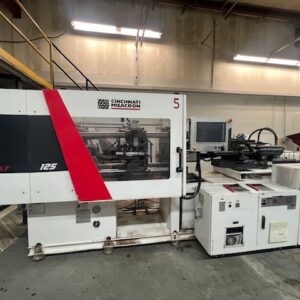Injection Molding Machines
Used Injection Molding Machines For Sale
Revelation Machinery offers used injection molding machines for sale. There are many factors to consider when purchasing a used injection molding machine. Some factors include manufacturer, tonnage, shot size, and power source, described in more detail at the bottom of this page. Our inventory of used injection molding machines for sale changes frequently, so it’s a great idea to subscribe to our new arrivals email list. This way you can stay up to date on all of our inventory of used plastic equipment.
If you don’t find the injection molding machine you are looking for, please contact us! Revelation Machinery can always help you find what you need. If you have any questions about injection molding machines or need to find a specific brand/type, please feel free to contact us! If you need to sell your used injection molding machine, do so here!
Found Results
Popular injection molding machine brands include Arburg, Battenfeld, Cincinnati, Demag, Engel, Haitian, HPM, Husky, JSW, Krauss Maffei, Milacron, Mitsubishi, Nissei, Robotshot, Sumitomo, Toshiba, Toyo, and Van Dorn, among others.
Injection molding machines, also known as IMMs, are ideal for forming high-volume, complex parts. A mold is injected with melted material, which is cooled into a solid-state. Although there are many IMM variations, the components always include the driving system, injection unit, and clamping unit. Material types and additional details on injection molding machine components are listed below.
IMM Driving System
Hydraulic: The most common driving system offers a lower price tag, a higher clamping force, and its components are more resistant to wear and tear. However, the energy consumption is highest with this drive method compared to other options, the operation is not as clean due to the required hydraulic oil, and the machine is noisier.
Electric: A full-electric injection molding machine is energy-efficient, quieter compared to a hydraulic model, and no hydraulic oil equals a cleaner operation. An Electric IMM is defined as having at least three main axes driven by servo motors – clamp movement, injection, and metering/plasticating.
Servo: Servo injection molding machines are identical to a full-hydraulic IMM, except with a hydraulic pump that’s driven by a servo motor. The servo motor results in energy savings since the output speed can be adjusted when traditionally it can’t be.
Hybrid: A hybrid IMM has the best features of both hydraulic and electric injection molding machines, including energy savings, accuracy, and high clamping force. The price point falls between an electric and hydraulic IMM.
IMM Injection Unit
Material Hopper: The material hopper in an injection molding machine is where the process begins. Raw plastic granules are poured into the hopper, then enters the IMM. Other names include feed hopper, material inlet, and simply hopper.
Plunger Type
- Screw Type: A rotating screw transfers raw plastic granules from the hopper to the heating unit and beyond.
- Plunger-Plunger Type: The first plunger transfers raw plastic granules from the hopper to the heating unit, while the second plunger transfers melted material into the mold through the nozzle.
- Screw-Plunger Type: This plunger combination rotates raw plastic granules via a screw from the hopper to the heating unit, then plunges the melted material into the mold through the nozzle.
Heating Unit: Raw plastic granules must be melted before entering the nozzle. Band heaters and coil or nozzle heaters maintain the temperature in nozzles. Cartridge and strip heaters are used to heat the molds and platens.
Nozzle: The most popular nozzle types include needle shut, torpedo, and open. Each has its own ideal use case.
Clamping Unit
Toggle vs. Hydraulic: Low tonnage machines are better suited for a toggle clamp. A hydraulic clamp provides more control over tonnage throughout the stroke, making it the best choice for a 150 – 1,000 ton IMM.
Horizontal vs. Vertical: The orientation of the clamping unit is often used to classify IMMs. Horizontal injection molding machines are most common, but vertical IMMs are more flexible and often a great choice when high tolerances are required or when a preformed product is being inserted into a mold.
Material types
ABS (acrylonitrile butadiene styrene), PET, Foam, Rubber, Silicone-liquid, thermoset, multi-shot, multi-color, thermoplastic, elastomer, HDPE, liquid silicone rubber, polyethylene, polypropylene, and nylon.












